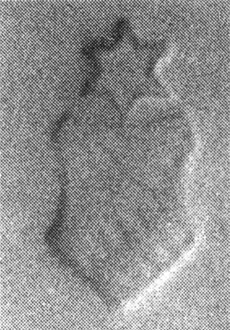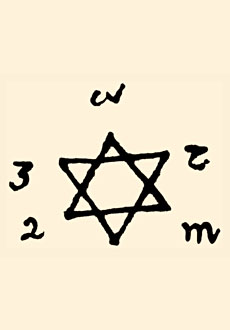|
|
Symbols mean what the user wants them to mean, and history demonstrates that meanings can often change. While the pentagram is a clear example of this, a related symbol, the hexagram, or Star of David, is also noteworthy.
|
ANTI-MASONRY REFUTED
ANTI-MASONRY FAQ
THE PENTAGRAM
|
|
|
|
The Star of David, or Magen David (Shield of David) historically was not limited to use by Jews and, like the pentagram, served as a magical sign or decoration. While the Jewish community of Prague adopted the Star of David as its official symbol in the 17th century, it continued to be used as a simple decoration or superstitious protection against evil spirits with no particular Jewish significance throughout the 18th and 19th centuries.
From the convening of the first Zionist Congress at Basel, Switzerland, by Austrian journalist Theodor Herzl, in 1897, the Star of David slowly fell out of use for any purpose other than Jewish identification.
The Nymphenburg porcelain factory press mark shows one non-Jewish use of the hexagram.
The first porcelain factory producing German hardpaste was established in 1747 at the castle of Neudeck, outside Munich, by Maximilian III Joseph, elector of Bavaria. In 1761 the factory was moved to Nymphenburg, on the outskirts of Munich, where it still operates. The Nymphenburg factory mark, adopted in 1754, is the Bavarian shield of arms.
 Rautenschild mit Rauten von links oben nach rechts unten, darüber ein großer Stern: Höhe ges. 10 bis 13 mm, je nach Größe des Objektes, 1890 - etwa 1905 [p. 437.]
Lozenge sign with lozenges from left to the right above down, over it a large star: Height of ges. 10 to 13 mm, depending upon size of the object, 1890 - c. 1905
Rautenschild mit Rauten von links oben nach rechts unten, darüber ein großer Stern: Höhe ges. 10 bis 13 mm, je nach Größe des Objektes, 1890 - etwa 1905 [p. 437.]
Lozenge sign with lozenges from left to the right above down, over it a large star: Height of ges. 10 to 13 mm, depending upon size of the object, 1890 - c. 1905
| |
 10 Flaschenvase »500« mit chinesischer Emallmalerei, um 1891 (o. Abb.)
10 Flaschenvase »500« mit chinesischer Emallmalerei, um 1891 (o. Abb.)
Entwurf Viktor Schäffner (Dekor),
Ausführung Edmund Stegmayer
Bunte Emailfarben
H. 33 cm, PM: RS m. kl. Stern-, MM: in Schwarz Imitation der Hexagramm-Marke, »4002/500/5« und »unverkäuf
lich« bez.
SIg. Bäuml Inv.Nr. CB 14
Publ.: Ziffer 1997, S. 377, Kat. 1380 m. Abb.
Auch dieses Modell, das in zwei Größen gefertigt wurde, geht direkt auf ostasiatische Vorbilder zurück. Der Dekor zwischen grüngrundigen Bordüren aus umlaufenden Friesen mit Blumen und Gittermustern zeigt auf der Wandung Drachen, Blumen und Schmetterlinge im chinesischen Stil. Auf dem Hals eine aufsteigende Dekorspirale aus Blütenmotiven. Goldstaffage. Der Dekor auf einer Vase dieser Größe findet sich im Musterbuch von 1822 auf Seite 38. Dieses Modell erwarb das Kunstgewerbemuseum in Dresden am 14. 12. 1891 zum Preis von 35 Mark.
10 bottle vase "500" with Chinese Emallmalerei, around 1891 (o. Abb.)
Draft Viktor Schaeffner (decoration),
Execution Edmund Stegmayer
multicolored emailfarben
H. 33 cm, PM: R-S m. kl. star -, mm: in black imitation of the hexagram mark, "4002/500/5" and "unverkaeuf lich" bez. SIg. Baeuml Inv.Nr. CB 14 publications: Number 1997, P. 377, Kat. 1380 m. Abb.
This model, which was manufactured in two sizes, is derived fromo East Asian models. That decoration between gruengrundigen bordueren from circulating Friesen with flowers and gittermustern shows on the wall kite, flowers and butterflies in the Chinese style. On the neck an ascending decoration spiral from motives for bloom. Goldstaffage. That decoration on a vase of this size is in the pattern book of 1822 on page 38. This model acquired by the Museum of Arts and Crafts in Dresden on 14. 12. 1891 at the price of 35 marks. [p. 24.]
|
Alfred Ziffer, Nymphenburger Moderne, München : Münchner Stadtmuseum, 1997. hc 466pp.
|
![[Grand Lodge]](../../images/hedn.jpg)
 Rautenschild mit Rauten von links oben nach rechts unten, darüber ein großer Stern: Höhe ges. 10 bis 13 mm, je nach Größe des Objektes, 1890 - etwa 1905 [p. 437.]
Rautenschild mit Rauten von links oben nach rechts unten, darüber ein großer Stern: Höhe ges. 10 bis 13 mm, je nach Größe des Objektes, 1890 - etwa 1905 [p. 437.]
 10 Flaschenvase »500« mit chinesischer Emallmalerei, um 1891 (o. Abb.)
10 Flaschenvase »500« mit chinesischer Emallmalerei, um 1891 (o. Abb.)